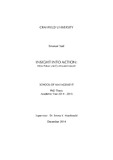JavaScript is disabled for your browser. Some features of this site may not work without it.
| dc.contributor.advisor | Macdonald, Emma K. | |
| dc.contributor.author | Said, Emanuel | |
| dc.date.accessioned | 2015-06-18T16:09:05Z | |
| dc.date.available | 2015-06-18T16:09:05Z | |
| dc.date.issued | 2014-12 | |
| dc.identifier.uri | http://dspace.lib.cranfield.ac.uk/handle/1826/9274 | |
| dc.description.abstract | Customer insight is fundamental for market oriented organizations to understand their markets. However, the use of customer insight in marketing decisions is poorly understood, partly due to the difficulties in obtaining research access within organizations. But in part because under the perspective of market-based learning (MBL) theory, knowledge is a fixed asset so while there has been interest in insight acquisition, there has been less interest in the processes of insight use. This doctoral research focuses on managers’ use of customer insight within the organisation. It applies the case research method within two organisations using multiple sources of data, including interviews with multiple individuals and real-time experience tracking over a period of time. A framework of the process of insight use is developed from a review of literature and then explored and expanded upon through case study analysis. The emergent framework provides a more granular understanding of the multiple stages of the customer insight use cycle within an organization. It identifies that the insight use process is a perpetual feedback loop learning mechanism and involves several stages identified as: acquiring, filtering, transforming, sharing, analysing/interpreting, actioning and storing. The study finds that some phases are more likely to involve an individual manager while others are more likely to involve managers working collectively. For instance, the stages of acquisition and transforming tend to be individual while the stages relating to interpretation and actioning of insight tend to be collective. Managers may also opt to store insight as their next step for potential actioning at a later stage after any of the process stages. In addition to identifying the stages of insight use, this study identifies the pivotal role of organizational memory in the insight use process. Enablers and blockers of insight use are identified including that managers may respond to perceived information overload by (consciously or unconsciously) blocking information.A key contribution of this thesis is that it incorporates the first use in an organizational behaviour context, of the real-time experience tracking (RET) method. This pioneering use of RET demonstrates that this method may address some of the limitations that plague traditional participant observation techniques in organizational settings, such as active or moderate participation. It demonstrates that RET can be used to track the insight use process of individuals in organizations over time, helping to understand their individual and collective insight use processes. This multi-informant, multi-method study of customer insight use thus provides a deeper understanding of the processes of customer insight use than most previous MBL studies, which have typically employed single-informant, cross-sectional survey approaches. Practitioner implications include that new individual competencies in information use may be needed and that organisations may need to foster a new code of etiquette for information sharing and feedback between peers in organizations operating in today’s information rich environment. | en_UK |
| dc.language.iso | en | en_UK |
| dc.publisher | Cranfield University | en_UK |
| dc.rights | © Cranfield University 2014. All rights reserved. No part of this publication may be reproduced without the written permission of the copyright holder. | en_UK |
| dc.title | Insight into action: how firms use customer insight | en_UK |
| dc.type | Thesis or dissertation | en_UK |
| dc.type.qualificationlevel | Doctoral | en_UK |
| dc.type.qualificationname | PhD | en_UK |
